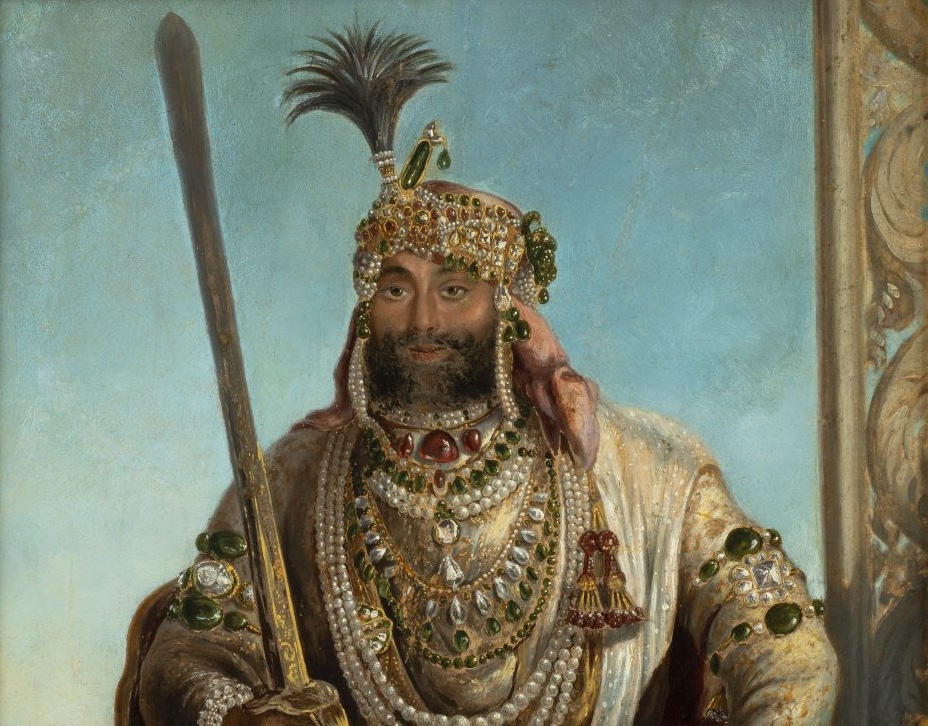LONDON — Ranjit Singh had a tough start to life. As a child, he lost an eye to smallpox; at 10, he lost his father. But beginning at the age of 16, he would fight — and win — wars against the overwhelmingly superior forces of the Afghan Durrani Empire, which sought to take advantage of the declining Mughal Empire to conquer key areas of the Punjab region. In 1801, at age 19, he would be named Maharaja of the Sikh Empire.
Ranjit Singh: Sikh, Warrior, King at the Wallace Collection explores the empire he ruled until his death in 1839. Fittingly, given the remarkable reputation of the museum’s armory, visitors are greeted at the exhibition entrance with one of the ornately engraved watered-steel talwars that belonged to the Maharaja.
Amidst a decor designed to mimic the stately intimacy of Indian palaces from which emperors like Singh ruled — rust-red and sporting numerous faux jaali, or the latticed stone screens that are a hallmark of Indo-Islamic architecture — the story of Singh’s rise to power is told in broad strokes. But the true throughline of the exhibition, rather than the accounts of his military prowess or the finely crafted weapons and armor that contributed to it, is the importance of the faith that sustained the empire.

Sikhism anchors Singh’s accomplishments to history writ large. His coronation was conducted by Sahib Singh Bedi, a descendant of Guru Nanak, the first of the Sikh Gurus. The core of his army comprised Sikh warriors hardened by decades of war serving within the 12 Sikh misls (kingdoms). His worldview as king were intrinsically shaped by the tenets of Sikhism, which advocated working to ensure universal prosperity for all.
This belief in equality led to an especially cosmopolitan polity, one where former commanders of Napoleon Bonaparte were actively recruited to modernize Singh’s army following the defeat of the French emperor at Waterloo. The collection boasts beautiful and occasionally incongruous artifacts as a result of this syncretic rule, such as a portrait of Hussar-Captain-turned-Sikh-General Jean-François Allard sporting an impressive beard and a letter about the friendship he helped facilitate between Singh and Louis Philippe I, the penultimate king of France.

The empire Singh created would be the final bulwark against the ravenous British East India Company (EIC), which would plunder large swaths of South Asia, but fell apart a decade after his death when it lost a series of wars with English colonial forces. Indeed, many of the art and artifacts on loan to the exhibition were looted by EIC officers following the kingdom’s collapse in 1849. The intricate golden throne created for Singh was shipped back to England. The fabled Koh-i-Noor diamond was forcibly stripped from Ranjit’s youngest son, 11-year-old Duleep, and handed over as a trophy to Queen Victoria. It continues to festoon the Crown Jewels of the United Kingdom to this day.
The receipt of this transfer is part of the set of artifacts that concludes the exhibition — but the legacy of Singh’s empire would live on for generations after its fall, shaping Sikh culture under the British Raj.
If the exhibition has a flaw, it is that its success in depicting the broad strokes of Singh’s life and his empire precludes granular details. Visitors will leave the Wallace Collection with a better understanding of the ruler, but not of those he ruled, whose lives are only briefly glimpsed in the footnotes of some of the sumptuous paintings, textiles, and jewelry on display. It’s a double-edged sword — unlike the magnificent single-edged talwars that helped forge Singh’s story.


© Toor Collection

Ranjit Singh — Sikh, Warrior, King continues at the Wallace Collection in London through October 20th. The exhibition was co-organized by Xavier Bray and Davinder Toor.


